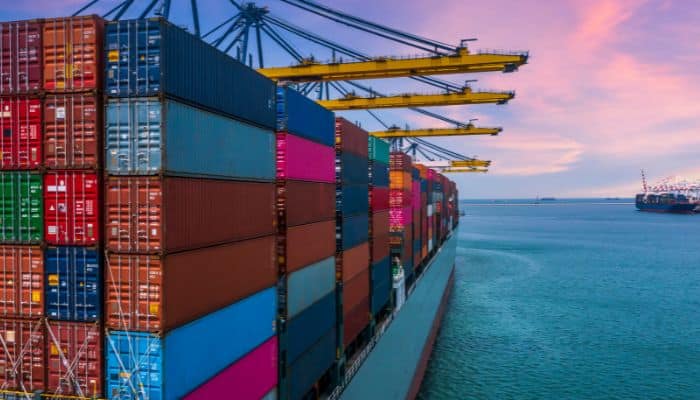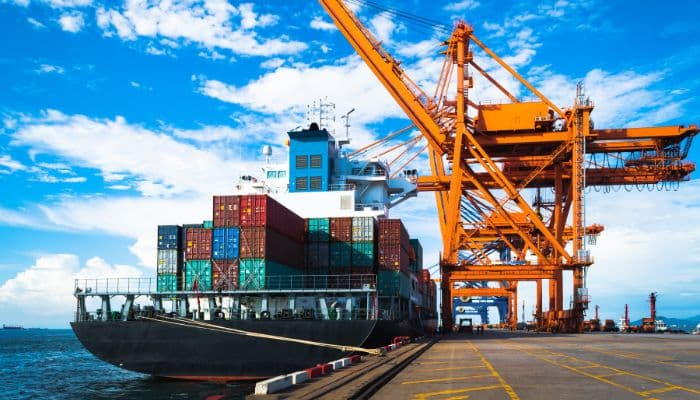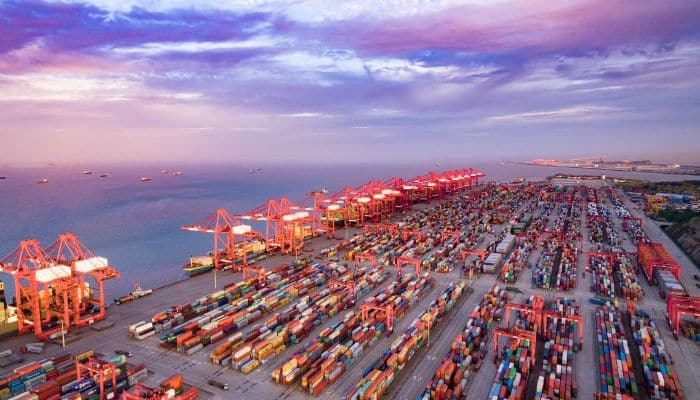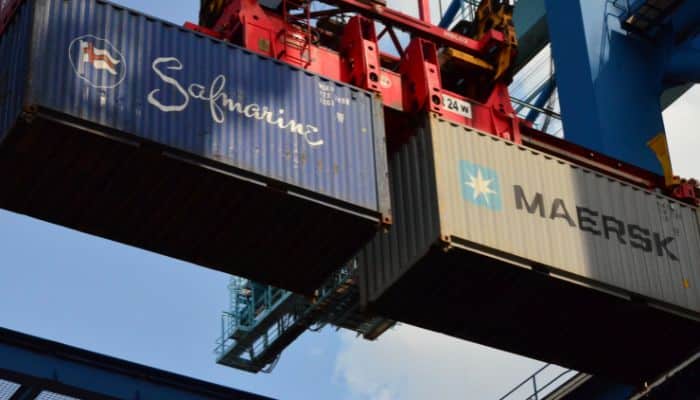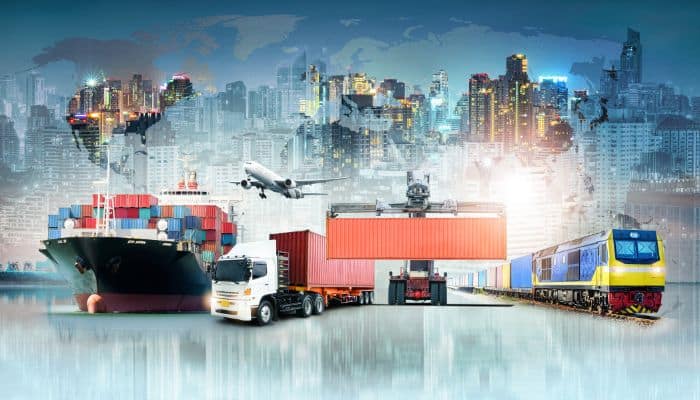What is GDP Multiplier Ratio in Shipping?
The GDP Multiplier Ratio is a relatively little-known concept. Still, it is widely used in container shipping while evaluating the potential of new markets, preparing commercial plans and formulating long-term strategies, and prioritising CAPEX allocation when deciding between competing target markets.
It is, in essence, a variant of the Trade Multiplier Ratios that are common in economic parlance and is frequently referred to in the container shipping industry, with executives of companies commonly quoting this number to quantify the prospects for the container shipping trade in any country or region (or at the global level).
The Ratio expresses the relationship between the growth rate of a given country’s GDP and the rate of growth of its containerised trade.
To illustrate with the help of a very simplistic example, if a country’s GDP grew at 10% in a particular year and its containerised trade grew 15%, its GDP Multiplier Ratio will be 1.5, indicating that the company’s containerised trade is growing 50% faster than its GDP.
Likewise, suppose another country’s GDP growth rate is 10% while its container trade grew at 20%. In that case, the GDP Multiplier Ratio is 2, indicating that the second country offers more potential in terms of container trade volumes.
Generally, there is a direct positive correlation between a country’s GDP and its exports and imports.
Countries with a higher GDP would obviously trade more volumes while developing countries with relatively lower GDP will have far lesser international cargo movement.
In the case of exports, a country with a higher GDP would most likely have a bigger manufacturing sector, implying more goods to be exported.
Likewise, a higher GDP would also indicate higher per capita income and higher purchasing power, which would translate into greater demand for imported goods.
Conversely, in the case of countries with lower GDP, the volume of export cargo would most likely be relatively lower, and the composition too would be unfavourable (low-value commodities or raw materials which can be transported as bulk rather than being containerised).
The potential for importing goods would also be lesser, given the weaker spending power of its population.
The GDP Multiplier Ration thus depicts how much stronger the positive correlation between GDP and Container trade is, thus providing a gauge of the likely trends in the development of container trade in that country.
In certain cases, however, such as for specific rapidly developing countries or during a bull cycle, when countries record high ratios, implying that there is greater potential for shipping companies as the country is experiencing a boom in exports and imports (and thus constitutes a fast-growing market).
Examples typically include rapidly industrialising countries in growth regions such as India or in the African continent.
This Ratio is one of the criteria used by the management of container carriers in decisions regarding which markets to serve and making strategic choices on countries/ regions they ought to focus on in the long term.
Since such decisions involve considerable CAPEX and OPEX and entail a long-term commitment to the selected market, the accurate evaluation of the potential of competing options is critical to the sustainable growth and profitability of the Carrier, basis which adequate assets will be deployed, wherefore due consideration needs to be given to the GDP Multiplier ratio (amongst other factors).
Usage of the GDP Multiplier Ratio
Container carriers use the Ratio while making varied decisions, the most common ones of which include:
1. Selecting between various competing markets to invest in
When a carrier intends to expand its geographical presence and sphere of activities, it is presented with questions related to which country to target.
Generally, there exists more than one potential market/country, each with its own pros and cons.
Since the proposed investment will be huge, carriers need to perform a thorough cost-benefit analysis and prepare a robust business case, which will form the basis for selection.
In this scenario, the GDP Multiplier Ratio is a crucial factor while evaluating the relative merits and demerits of each market.
2. Allocation of capacity
Often, expansion doesn’t necessarily mean entering a new market but strengthening its presence in existing markets. In the case of container carriers, this means allocating additional capacity (in the form of vessels, resources and equipment) to a country they already serve.
This, once again, is an expensive investment, and there also exist opportunity costs, wherefore Carriers must exercise due caution while infusing capacity in any particular market.
In such situations, the Ratio is a good tool to justify the deployment of incremental tonnage.
3. Formulating long-term growth strategies
Given the cyclical nature of the container shipping industry, it is imperative for carriers to frame long-term strategies to adapt to the various market cycles, surviving during troughs and maximising profits during peaks.
These strategies include CAPEX in new vessels, as well as decisions on which markets they will serve upon being commissioned (or could be the other way round where the Carrier decides the target market and then orders vessels that are apt for the trade selected – such as procuring vessels with more reefer capacity for vessels intended to ply the South America trades).
The GDP Multiplier Ratio helps in these decisions as well.
The Ratio is obviously to be analysed in conjunction with a wide range of diverse factors, such as:
1. Total container trade volumes
Less-developed countries which have recently embarked upon large-scale industrialisation drives will see their container trade grow at a fast clip (due to higher exports) while their GDP growth will be more measured. Its GDP Multiplier Ratio will therefore be higher (as a ratio or percentage), but the total number of EXIM containers (in absolute terms) will not be as impressive.
Similarly, highly developed countries with a low ratio might, in fact, have a thriving container trade, representing a lucrative market for carriers.
Also, even though the ratio might be low, the fact that it is calculated off a high base means that in absolute terms, even the low percentage will translate into far higher volumes.
This holds true for developed countries, which have already achieved high rates of industrialisation and whose current manufacturing and exports levels are significant, wherefore GDP growth will be driven by factors other than exports, denoting that the growth in containerised trade will be more or less commensurate with growth in overall GDP.
In view thereof, relying solely on the Ratio will present a misleading picture of the country’s potential for containerised transport.
Carriers will therefore need not just to view the ratio in isolation but also consider the volumes in absolute terms that the ratio represents.
2. Scope for containerisation
Containerisation refers to the process of transporting commodities in containers which were hitherto transported in bulk.
As the benefits of containerisation become obvious, more and more commodities are being transported in commodities.
The number of commodities and volumes thereof which have the potential of being transported via containers defines the scope and pace of containerisation in a country.
So, we might have countries whose GDP multiplier ratio is not very high but where existing low containerisation levels mean there is considerable scope for container carriers to try to have these commodities transported via containers.
This is, therefore, another factor that carriers need to be cognizant of while evaluating the potential of any market.
3. Export/import location split, rather than viewing the aggregate ratio in isolation
Besides the forecasted growth in container trades, as inferred from the GDP Multiplier Ratio, Carriers also analyse the corridors and import/ export locations to determine the profitability and viability of the projected volumes.
If the incremental volumes are anticipated to flow to/ from markets which are already overserved, carriers might find that the fierce competition renders the business commercially unviable.
Likewise, suppose the trading partner is subject to sanctions. In that case, regardless of the volume of cargo, carriers will refrain from plying the trade to avoid falling afoul of the sanctions imposed (and thus exposing themselves to penalties or restrictions in the broader global market).
Historical developments in GDP Multiplier Ratio and current scenario
Considering that the GDP Multiplier Ratio is a function of a multitude of factors such as increased globalisation, geographical dispersion of supply chains, enhanced international trade connectivity, and offshoring of production to low-cost locations, it is not surprising that the ratio rose steadily since the 1980’s when globalisation became the norm.
China first started becoming the preferred manufacturing location for Western corporations.
The ratio rose steadily from the 1980s to 2008, with values ranging from slightly over 2 to 6 at varying periods in time. The years from 2000-08 saw exceptionally strong development, with an average value of 3.3, coinciding with the strong bull run in the global economy and the container shipping trade.
The recession of 2009 upended the strong positive correlation between GDP and container trade growth, and the ratio started declining gradually over the years.
As the fortunes of the container shipping industry waxed and waned in the subsequent years, the ratio dipped to around 1 and hovered in a narrow range thereafter, indicating that the rates of growth for both the GDP and container trade are on par.
This implies that container trade has to some extent, plateaued, and we will likely witness a moderation from the previously high rates of containerisation.
Post Covid (which turned on its head the traditional dynamics of the container shipping business), given how altered the commercial aspects were, it would be futile to draw any conclusion from the Multiplier ratio.
The reconfiguration of trade routes and realignment of sourcing patterns meant that growth in GDP rates did not accurately mirror the growth in container trade, rendering it difficult to draw meaningful inferences therefrom.
In 2023, as the disruptive pressures dissipate and the container shipping industry shows signs of returning to normalcy, we will likely see a greater correlation between the GDP and Container trade.
The ratio, however, is not expected to surpass the values recorded in the pre-Covid period, indicating that at a country level, growth in container trade is expected to be commensurate with the growth in GDP.
You might also like to read-
- What are Trans-Shipment And Trans-Shipment Ports?
- Understanding Maritime Towage And Salvage
- Advantages And Disadvantages Of Bigger Vessels For Exporters, Shippers & Cargo Owners
- Understanding Supply Chain Resilience
- What Do You Mean By Humanitarian Logistics?
Disclaimer: The authors’ views expressed in this article do not necessarily reflect the views of Marine Insight. Data and charts, if used in the article, have been sourced from available information and have not been authenticated by any statutory authority. The author and Marine Insight do not claim it to be accurate nor accept any responsibility for the same. The views constitute only the opinions and do not constitute any guidelines or recommendations on any course of action to be followed by the reader.
The article or images cannot be reproduced, copied, shared, or used in any form without the permission of the author and Marine Insight.
Do you have info to share with us ? Suggest a correction

About Author
Jitendra has over 20 years of international experience in the Container Shipping, Ports and Logistics industry, spanning 3 diverse geographies, wherein he has been involved in the commercial and strategic aspects of the container business.
Latest Maritime law Articles You Would Like:
Latest News
- What are Logistics Risks?
- How Port and Terminal Operators Can Control Emissions?
- Minimum Quantity Commitment (MQC) and Liquidated Damages in Container Shipping: Concept and Relevance
- MARPOL (The International Convention for Prevention of Marine Pollution For Ships): The Ultimate Guide
- The Ultimate Shipping Container Dimensions Guide
- A Comprehensive Overview of IMDG Code for Shipping Dangerous Goods
Subscribe To Our Newsletters
By subscribing, you agree to our Privacy Policy and may receive occasional deal communications; you can unsubscribe anytime.
Web Stories



